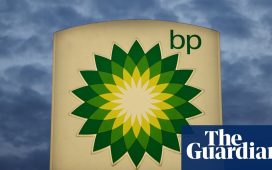The UK’s annual inflation rate fell sharply to 4.6% in October on the back of cheaper gas and electricity, its lowest level for two years.
Marking the steepest single month decline in the consumer prices index (CPI) since 1992, the fall from 6.7% in September also beat the 4.8% figure predicted by a poll of economists for Reuters.
The decline does not mean prices are going down, only that they are rising less rapidly. Nevertheless, the reading is expected to ease fears that the Bank of England will increase interest rates again this year, despite being more than twice its 2% target.
It also means Rishi Sunak has achieved his target set in January of halving inflation by the end of the year from the 10.7% average in the last quarter of 2022.
The prime minister said: “In January I made halving inflation this year my top priority … Today, we have delivered on that pledge.”
Labour said the government should resist the urge to pop champagne corks after two years of rocketing prices that have left “working people worse off with higher mortgage bills, prices still rising in the shops and inflation twice as high as the Bank of England’s target”. The Office for National Statistics (ONS) said the price of food was about 30% higher than it was in October 2021.
Suren Thiru, the economics director at the Institute of Chartered Accountants in England and Wales, said that while the figures suggested the UK had turned the corner in its battle against soaring inflation, “this owes more to the downward pressure on prices from falling energy costs and rising interest rates than any government action”.
Thiru added: “Although subsequent declines will be more modest, the drag on demand from a softening jobs market and high interest rates may mean that inflation falls back to the Bank of England’s 2% target more quickly than they currently expect. This fall in inflation seals the deal on a December interest rate hold.”
The chancellor, Jeremy Hunt, said the government could take some credit after it “took some very difficult decisions to control borrowing and debt” to limit spending in the economy and the pressure on prices. His comments appeared to signal that the autumn statement next month would be restrained in its spending commitments to maintain the trend for inflation to fall.
Amid reports that the chancellor could try to save up to £1bn by switching to using October’s far lower inflation reading for next April’s working age benefits uprating, rather than the usual September figure, charities said such a move would be “indefensible” and entail a “big cut” for struggling families.
Separate figures from the ONS showed UK house prices fell 0.1% in the year to September – the first annual drop in 11 years. The average house sale value, including cash buyers, fell to £291,385, down from £292,882 in August.
Meanwhile, private tenants suffered a 6.1% average increase in rent in the 12 months to October, the largest annual percentage change since ONS records began in January 2016.
after newsletter promotion
At the heart of October’s decline in CPI was the 23% year-on-year cut in the energy price cap for the typical annual gas and electricity bill, from £2,500 last October to £1,923 the same month this year.
Food price inflation was the lowest since 2021 after a drop in the annual rate of increase to 10.1% in October, down from 12.2% in September and a recent high of 19.2% in March 2023 – the highest annual rate for more than 45 years.
Restaurant and hotel prices, which have played a large part in driving inflation over the past year, remained the same between September and October, compared with a rise of 1% between the same two months a year ago.
Shares rose on markets after the larger than expected fall in UK CPI. The FTSE 100 index of leading shares in London increased by almost 1% to 7,502, reinforcing bets by investors that the Bank of England is likely to begin cutting interest rates earlier than previously expected, and possibly as early as May 2024.
The measure for core inflation, which strips out volatile items such as energy and food, also dropped by more than analysts expected but remained high. The ONS said it slid from 6.1% to 5.7%, slightly below the 5.8% forecast by City economists and the Bank of England.
A comparison with other leading economies showed that UK inflation remained one of the highest. In the US, the CPI declined from 3.7% to 3.2% in October, while in France it fell to 4.5% and Germany to 3%.











